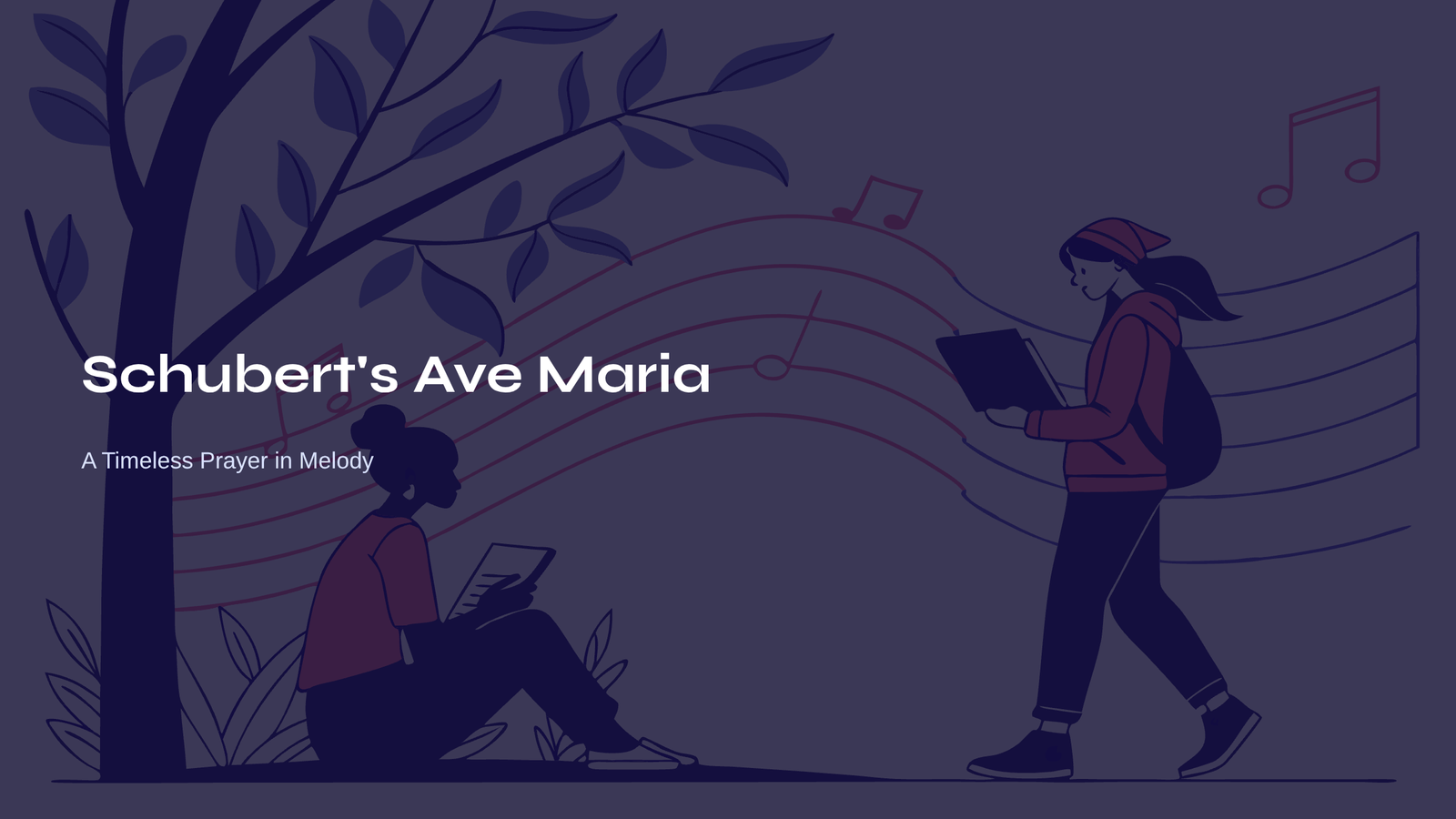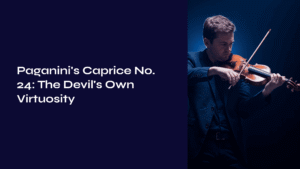Table of Contents
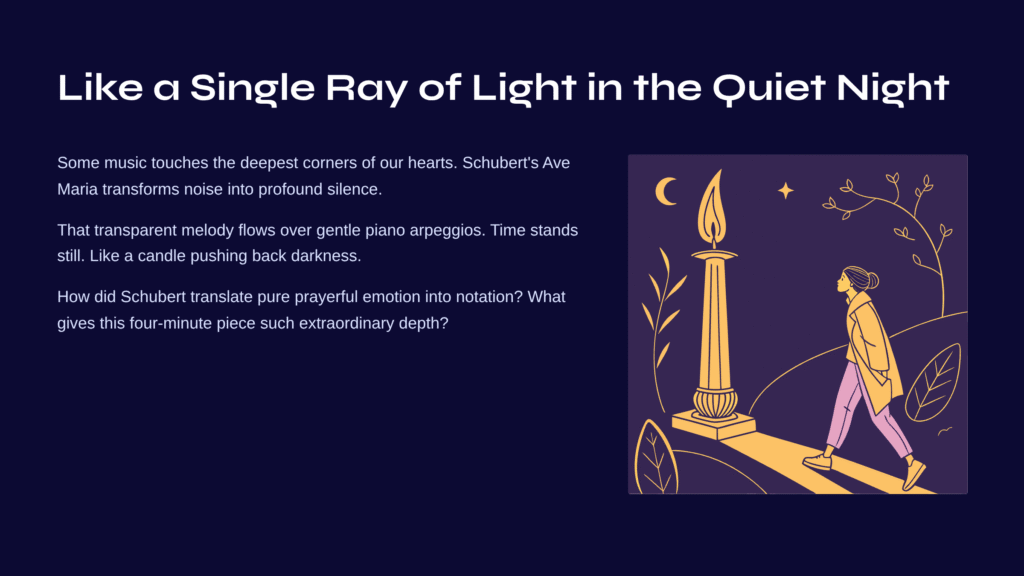
Like a Single Ray of Light in the Quiet Night
Some music touches the deepest corners of our hearts from the very first note. Schubert’s Ave Maria is one such piece. When you hear that transparent melody flowing over the piano’s gentle arpeggios, you experience something close to time standing still. Like a single candle pushing back the darkness, this song transforms the noise in our minds into profound silence.
Every time I listen to this piece, I find myself wondering: How did Schubert manage to translate such pure prayerful emotion into musical notation? What is it about this brief four-minute composition that contains such extraordinary depth?
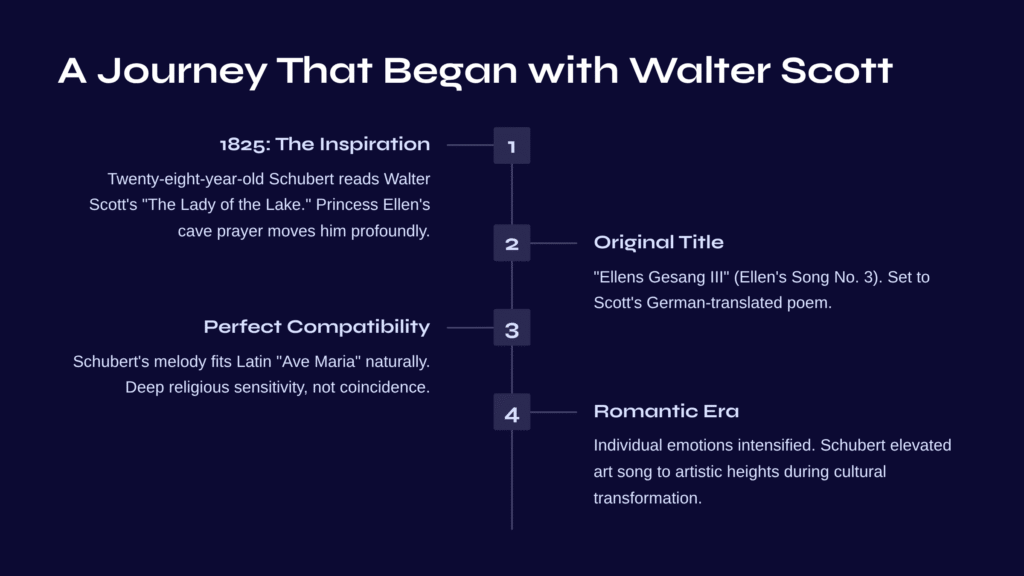
A Journey That Began with Walter Scott
In 1825, twenty-eight-year-old Franz Schubert was reading Walter Scott’s narrative poem “The Lady of the Lake.” Within its pages, he discovered a scene where Princess Ellen prays earnestly to the Virgin Mary in a cave, and this moved him profoundly. The original title was “Ellens Gesang III” (Ellen’s Song No. 3), setting music to Scott’s poem translated into German.
Fascinatingly, this piece became better known to us as “Ave Maria” because Schubert’s melody fits perfectly with the Latin prayer text “Ave Maria.” There’s something so natural about this compatibility, as if the music had been composed specifically for those sacred words from the beginning. This seems less like coincidence and more like the result of Schubert’s deep religious sensitivity.
This was the era of Romanticism in full bloom. As interest in individual emotions and inner worlds intensified, music became increasingly lyrical and personal. Schubert was the composer who elevated the art song genre to truly artistic heights during this cultural transformation.
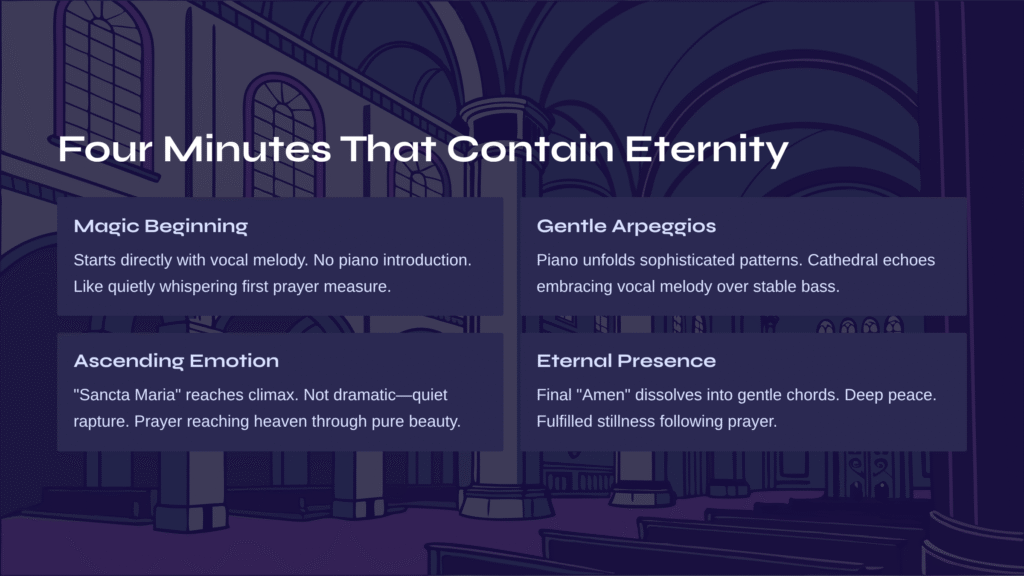
Four Minutes That Contain Eternity
The Magic Beginning with the First Note
This piece begins directly with the vocal melody, without any piano introduction. This is quite an unusual structure that creates the effect of someone quietly opening their mouth to whisper the first measure of a prayer. The moment the first words “Ave Maria…” fall, we’re already drawn into that world of devotion.
The piano accompaniment unfolds gentle arpeggios in the right hand over a deep, stable bass line in the left. These arpeggios appear simple but are actually quite sophisticated. Like echoes resonating through the high vaults of a cathedral, they embrace and support the vocal melody.
The Ascending Arc of Emotion
As the piece progresses toward its middle section, the melody gradually rises to higher registers. Particularly in the “Sancta Maria” passage, the music reaches its emotional climax. But this climax isn’t passionate or dramatic—it’s more like quiet rapture. It seems to express the overwhelming joy of an earnest prayer reaching heaven.
Here we see Schubert’s genius at work. He chose to express religious awe not through exaggerated or theatrical means, but through pure, simple beauty. This approach is completely different from Bach’s magnificent religious music or Mozart’s brilliant masses.
Eternal Presence in the Fading Echo
In the final section, the melody grows quiet again. When the last “Amen” dissolves into the piano’s gentle chords, we sink into deep peace. This moment of silence isn’t mere quietness—it’s the fulfilled stillness that follows prayer.
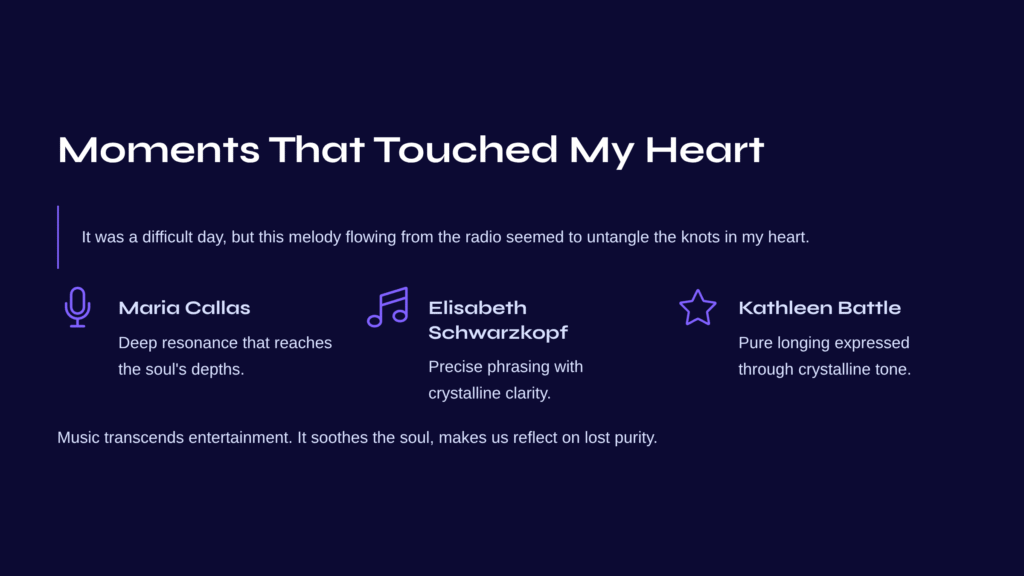
Moments That Touched My Heart
I have vivid memories of hearing this piece for the first time. It was a particularly difficult day, but this melody, flowing unexpectedly from the radio, seemed to untangle the knots in my heart. Even though I didn’t fully understand the lyrics, the music itself was comfort enough.
Since then, listening to various interpretations has taught me something profound. Maria Callas’s deep resonance, Elisabeth Schwarzkopf’s precise phrasing, Kathleen Battle’s crystalline tone… each brings a different kind of beauty, but at their core, they share something essential: pure longing.
Sometimes, listening to this piece makes me reflect on myself. It makes me consider what purity I’ve lost in the complexity of daily life, and where true comfort really comes from. When music transcends mere entertainment for the ears and actually soothes the soul—isn’t that exactly this kind of experience?
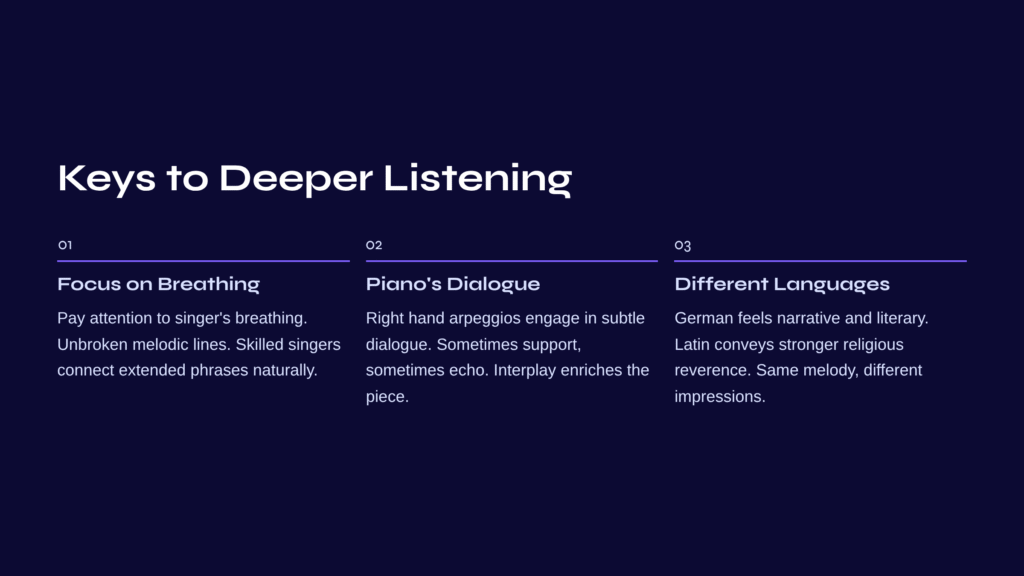
Keys to Deeper Listening
First Key: Focus on the Breathing
When appreciating this piece, pay special attention to the singer’s breathing. Schubert created this as an unbroken, long melodic line. Skilled singers manage to connect these extended phrases naturally while making subtle dynamic adjustments according to the text’s meaning. Like reciting poetry, try to feel the flow of the musical sentences.
Second Key: The Piano’s Dialogue
It’s easy to focus only on the vocal melody, but don’t overlook the piano accompaniment. The right hand’s arpeggios aren’t simple repetition—they engage in subtle dialogue with the melody. Sometimes they support the vocal line, sometimes they follow like an echo. This interplay between piano and voice makes the piece infinitely richer.
Third Key: Listen in Different Languages
Try listening to both the original German text and the Latin “Ave Maria” version. The same melody creates completely different impressions depending on the language. The German version feels more narrative and literary, while the Latin version conveys stronger religious reverence. Comparing these versions will reveal the multilayered beauty of Schubert’s music.
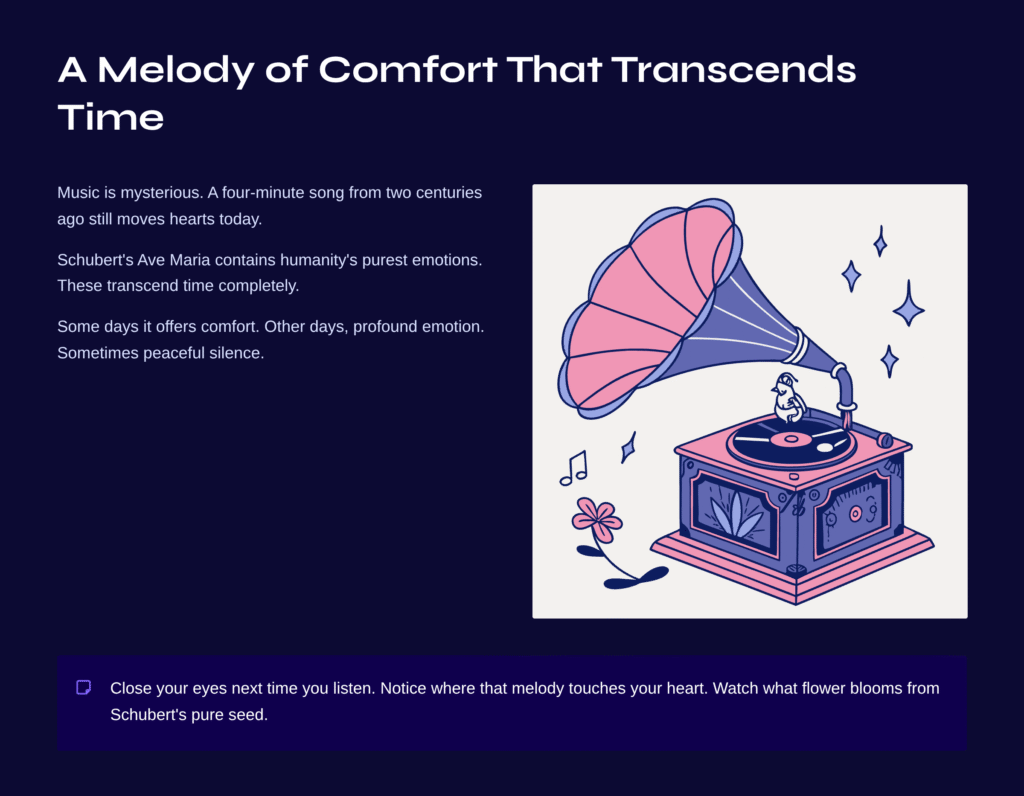
A Melody of Comfort That Transcends Time
Music is truly mysterious. A four-minute song written two centuries ago still moves our hearts today. Schubert’s Ave Maria goes beyond mere beautiful melody—it contains the purest emotions humans can experience. These emotions transcend time.
Some days this piece offers gentle comfort, other days it brings profound emotion. And sometimes it leads us into peaceful silence. Isn’t this the true power of art? The kind of embrace that says whatever you feel is valid, whenever you listen it’s always fresh.
Next time you hear this piece, close your eyes for a moment and notice where that melody touches your heart. Watch what kind of flower blooms in your soul from that pure seed Schubert planted two hundred years ago.
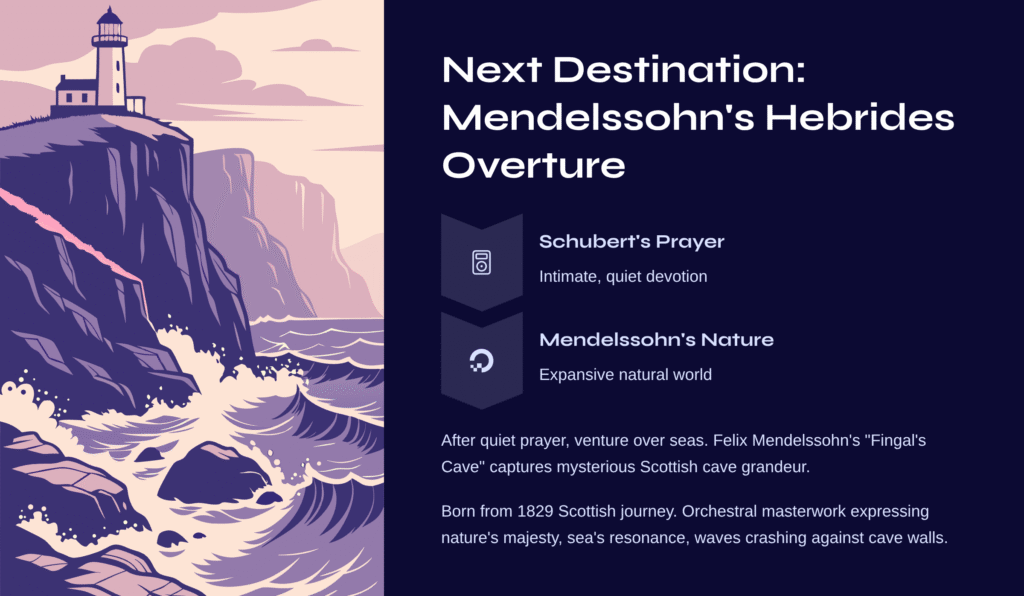
Next Destination: Mendelssohn’s Hebrides Overture “Fingal’s Cave”
After Schubert’s quiet prayer, shall we venture out over the seas? Felix Mendelssohn’s Hebrides Overture “Fingal’s Cave” is a work inspired by a mysterious cave off the Scottish coast.
This piece, born from Mendelssohn’s 1829 Scottish journey where he witnessed the grandeur of Fingal’s Cave firsthand, is a masterwork that captures nature’s majesty and the sea’s mysterious resonance through orchestral music. You can experience through music the echoes created by waves crashing against cave walls, the sounds of wind threading through rocky crevices, and the vast breathing of nature that encompasses it all.
From Schubert’s intimate prayer to Mendelssohn’s expansive natural world—this too represents another journey of emotion that Romantic music offers us.
